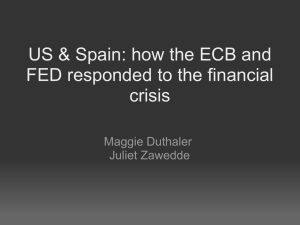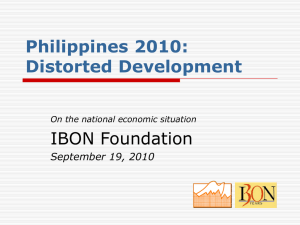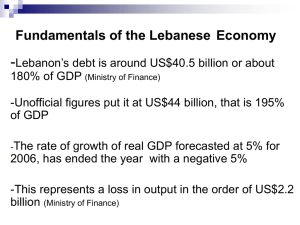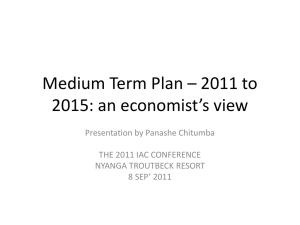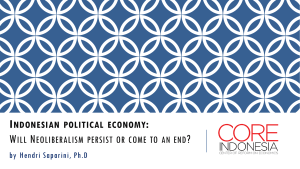Presentation: power point format
advertisement
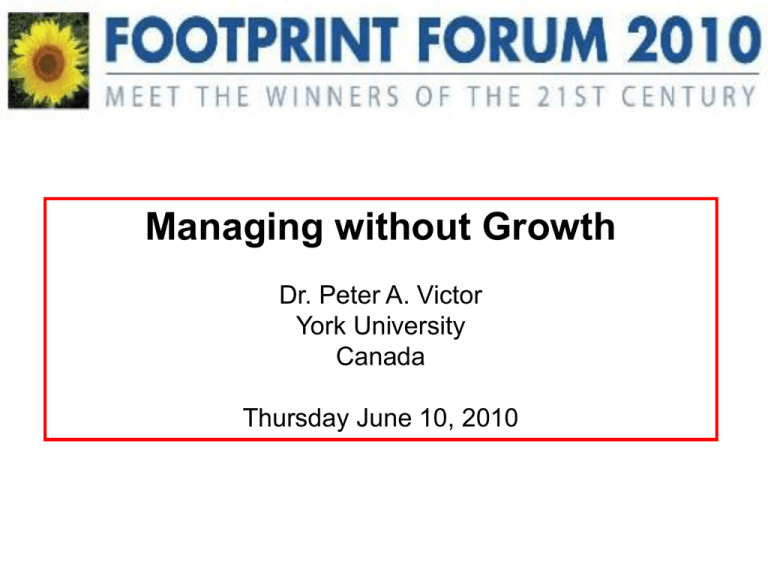
Managing without Growth Dr. Peter A. Victor York University Canada Thursday June 10, 2010 Outline 1. 2. 3. 4. 5. The economy: a sub-system of the biosphere Transgressing planetary boundaries Technology: helpful but not sufficient Scale matters Extreme global inequalities: rich countries should go first 6. Managing without growth in Canada Firms Economic Cycle Households 1. The economy: a sub-system of the biosphere Firms Economic Cycle Households 2. Excessive Burden on the Environment: Transgressing Planetary Boundaries Billion tonnes 700% 100% Global Materials Extraction 1900 to 2005 3. Technology: helpful but not sufficient 1946 1992 1970 2010 1946 1992 1970 2010 ‘I would say this is most environmentally friendly cruise ship to date. It is much more efficient than other similar ships.’ (Project engineer) intensity 4. Material Must address scale is as declining, well as intensitybut not fast enough 250 200 GDP 110% Resource Extraction 150 47% 100 50 Material Intensity 29% Key message: Environmental impact depends on intensity and scale 0 1980 1985 GDP 1990 Resourc e extrac tion 1995 Populat ion 2000 2005 Material int ensit y Energy consumption - same story 250 200 GDP 110% Primary Energy 150 59% 100 50 Energy Intensity 24% Key message: Environmental impact depends on intensity and scale 0 1980 GDP 1985 1990 1995 Population Primary Energy Consumption 2000 2005 Energy Intensity 5. Extreme global inequalities: rich countries should go first 5. Managing without growth Can we have full employment, no poverty, fiscal balance, reduced GHG emissions without relying on economic growth? LowGrow Canada You bet! LowGrow Canada What makes an economy grow? • Macro demand (what we spend money on): – – – – Consumption Investment Government Trade • Macro supply (what we can produce): – Labour – Capital – Productivity ‘Business as usual’ GDP per Capita 300 GHG Emissions 250 Poverty 200 150 100 Debt to GDP Ratio Unemployment 50 0 2005 2010 2015 2020 GDP per capita Unemployment GHG emissions Poverty 2025 2030 2035 Debt to GDP ratio What happens if we eliminate increases in all sources of economic growth? (starting in 2010 over 10 years) • Consumption • Investment • Government • Trade • Population/labour • Productivity A no growth disaster 300 Unemployment 250 Poverty 200 GDP per Capita 150 100 50 Debt to GDP Ratio GHG Emissions 0 2005 2010 2015 2020 GDP per capita Unemployment GHG emissions Poverty 2025 2030 2035 D ebt to GDP ratio Larry Elliot (economics editor) The Guardian Weekly 29th August 2008 ‘The real issue is whether it is possible to challenge the “growth-at-any-cost model” and come up with an alternative that is environmentally benign, economically robust and politically feasible.’ A better low/no growth scenario How? • New meanings and measures of success • Limits on materials, energy, wastes and land use • Stable population and labour force • More efficient capital stock • Carbon price • Shorter work year • Fewer status goods • More generous anti-poverty programs • Education for life not just work Unemployment 300 250 200 150 100 GDP per Capita GHG Emissions 50 Poverty Debt to GDP Ratio 0 2005 2010 2015 2020 GDP per capita Unemployment GHG emissions Poverty 2025 2030 2035 Debt to GDP ratio

